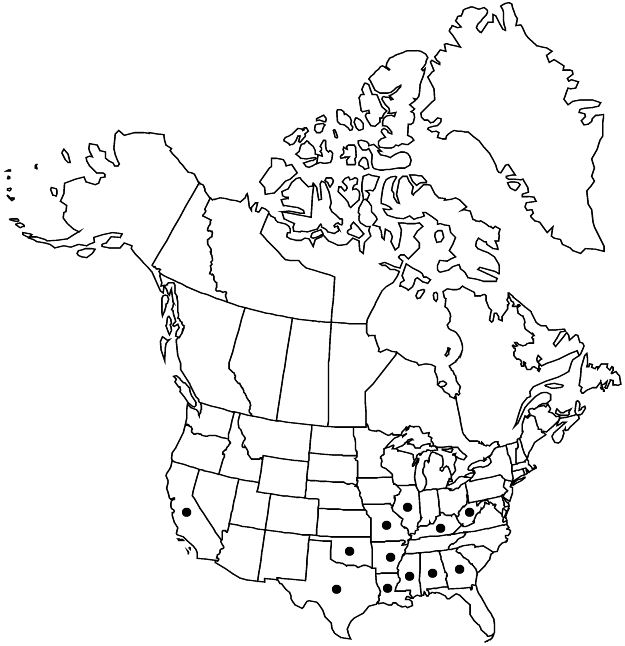Cucurbita melopepo
Sp. Pl. 2: 1010. 1753.
Plants annual; roots taproots or fibrous. Stems creeping or climbing, rooting adventitiously at nodes, sometimes bushy to shrublike in cultivated forms, to 3 m, densely puberulent to hirsutulous, with scattered, longer hairs with from strongly to weakly pustulate (many-celled) bases absent or present; tendrils 2–7-branched 2–3 cm above base, hirsutulous to pubescent, eglandular, tendrils sometimes absent in plants with bushy habit. Leaves: petiole 4–9(–16) cm, hispidulous to hirsutulous, sometimes minutely stipitate-glandular; blade sometimes white-spotted, broadly ovate-cordate to triangular-cordate or suborbiculate, shallowly to deeply palmately (3–)5–7-lobed, 4–15(–18) × 5–17(–23) cm, ± as broad as long, base cordate, lobes ovate-deltate to obovate or obovate-rhombic, midveins of leaf lobes not distinctly elongate-whitened, margins denticulate to serrate-denticulate, surfaces hispidulous to hirsutulous, eglandular. Peduncles in fruit 5-ribbed, slightly expanded at point of fruit attachment, hardened, woody. Flowers: hypanthium campanulate, 8–12 mm; sepals linear to subulate-linear, 8–25 mm; corolla yellow to golden yellow or orange, tubular-campanulate, 4–10 cm; anther filaments glabrous; ovary pubescent. Pepos wholly light to dark green, green with white stripes, or minutely cream- or green-speckled to slate blue, ivory, yellow, orange, or bicolored green and yellow, globose or depressed-globose to ovoid, obovoid, ellipsoid-ovoid, broadly ellipsoid, slightly pyriform, cushion-shaped, or cylindric, 4–10 cm, smooth, ribbed, or warty, flesh yellow to light orange or greenish or whitish, bitter or not. Seeds whitish to cream or tawny, narrowly to broadly elliptic to obovate, rarely orbiculate, 7–15(–26) mm, margins raised-thickened and smooth, surface ± smooth. 2n = 40.
Distribution

Ala., Ark., Calif., Ga., Ill., Ky., La., Miss., Mo., Okla., Tex., W.Va., Mexico, introduced widely.
Discussion
Subspecies 3 (2 in the flora).
The wild race of Cucurbita melopepo endemic to northeastern Mexico (Nuevo Léon and Tamaulipas) is subsp. fraterna (L. H. Bailey) G. L. Nesom, representing a single variety, var. fraterna (L. H. Bailey) G. L. Nesom [C. fraterna L. H. Bailey; C. pepo var. fraterna (L. H. Bailey) Filov et al.; C. pepo subsp. <fraterna (L. H. Bailey) Lira, Andres & M. Nee]. These plants grow in lowlands (below 900 m) and are common as weeds in agricultural fields (R. Lira et al. 2009). Variety fraterna is indicated to have a sister relationship to the more northern elements of C. melopepo (D. S. Decker et al. 2002b).
Evidence indicates that most or all of the domesticated forms of Cucurbita melopepo (var. melopepo) are derived from var. ozarkana (see comments below). For consistency within Cucurbita and other genera where wild progenitor/domesticate pairs are identified at subspecific rank, the var. melopepo domesticates are recognized also as subsp. melopepo, coordinate with C. melopepo subsp. texana (Scheele) G. L. Nesom, which comprises the two wild varieties of the United States.
The discrete, molecularly delineated lineages within Cucurbita melopepo are not so clearly distinguished by morphological features other than mature fruit shape and size. The key below uses features provided in discussions accompanying the molecular studies. Variation in potentially diagnostic features, especially in vestiture and fruit coloration, suggests that further study is needed.
Selected References
None.
Key
| 1 | Pepos solid or striped, multiple colors, including yellow and orange, rind smooth, ribbed, or warty, flesh nonbitter (except for some ornamental gourd cultivars); seed germination within 3–15 days, depending on cultivar. | Cucurbita melopepo subsp. melopepo |
| 1 | Pepos solid ivory or green-and-white-striped but usually not yellow or orange, rind smooth, flesh almost always bitter; seed germination within 1–7 days. | Cucurbita melopepo subsp. texana |